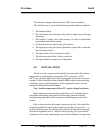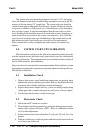
Part III: 1-21
Oil in Water Part III
Teledyne Analytical Instruments
4.1.5 Sample Delivery System
The sample delivery system should be designed to operate at the full
capacity of the interconnecting pipe. Ideally, both the sample and bypass
valves should be adjusted to maximum so that the only impedance to sample
flow is the length and diameter of the delivery pipe. Such a delivery system
will virtually eliminate problems associated with oil and debris collecting in
the sample line. Air ingestion will also be reduced to a minimum, as will
analysis lag time.
TET/AI recommends that the sample line be constructed of 1/2” sched-
ule 80 PVC pipe capable of pressure to 150 psig maximum. Unless abso-
lutely necessary, do not install any valves or restrictions in the line other than
those required to bypass the customer installed external sample pump. All
control over sample flow should be performed at the system inlet and the
pump if provided be allowed to operate at full efficiency against only the
resistance of the line.
A pump is required only if there is insufficient pressure to lift the
sample to the top of the system equipment panel. Do not complicate the
delivery system by adding a pump unless it is absolutely necessary. A low
pressure system will be prone to sample line depositing, but this can be
alleviated by scheduled flushing with the high pressure utility water.
If a pump is required, TET/AI recommends a total submersion centrifu-
gal type. Sub- merging the pump in the sample water automatically elimi-
nates the most common problem - priming the pump. Also, the sample
should be drawn from a point where there is a minimum of turbulence; in
this way, air or turbid suspended solids will not be ingested along with the
water.
The intake side of the system should be equipped with a coarse screen
filter. However, do not filter the water downstream from the sample point,
or use a fine filter anywhere in the sampling system. High filtration will
prevent a representative analysis of the undissolved oil in the sample water.
The inlet of the pump should be placed at a depth where the best
representative concentration of oil can be obtained. Positioning will vary
with the application; however, as a general rule, to avoid skimming, the inlet
should be about 2 feet beneath the surface of the sample water.
4.1.6 Safe Vent (Drainage)


















